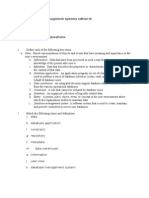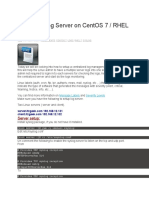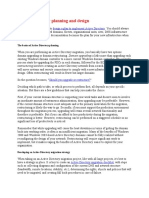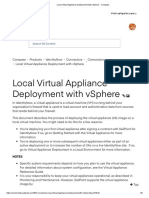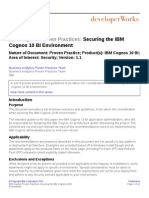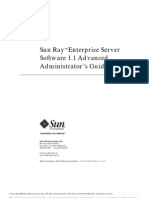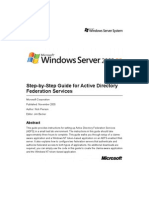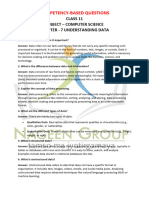Creating Users and Groups
Creating Users and Groups
Uploaded by
DataStage4YouCopyright:
Available Formats
Creating Users and Groups
Creating Users and Groups
Uploaded by
DataStage4YouCopyright
Available Formats
Share this document
Did you find this document useful?
Is this content inappropriate?
Copyright:
Available Formats
Creating Users and Groups
Creating Users and Groups
Uploaded by
DataStage4YouCopyright:
Available Formats
Creating users and groups
http://publib.boulder.ibm.com/infocenter/iisinfsv/v8r7/advanced/print.jsp?topic=/com.ibm.swg.im.iis....
Creating users and groups
Contents
1. Default and preconfigured users 2. Creating users in the IBM InfoSphere Information Server console 3. Creating groups in the IBM InfoSphere Information Server console 4. Adding users to a group in the IBM InfoSphere Information Server console 5. Creating users in the IBM InfoSphere Information Server Web console 6. Creating groups in the IBM InfoSphere Information Server Web console 7. Adding users to a group in the IBM InfoSphere Information Server Web console 8. Permissions and groups configuration (Windows Server 2008) 8.1. Configuring permissions and groups (Windows Server 2008) 8.2. Configuring permissions and groups (Windows Server 2008 domain controller) 8.3. Configuring write permission to the registered-servers.xml file
1 of 23
4/12/2012 6:55 PM
Creating users and groups
http://publib.boulder.ibm.com/infocenter/iisinfsv/v8r7/advanced/print.jsp?topic=/com.ibm.swg.im.iis....
IBM InfoSphere Foundation Tools IBM InfoSphere Information Server, Version 8.7.0 Feedback
User and group creation
Create users as the first level of security. You must create a user for each person who will log in to IBM InfoSphere Information Server. If the InfoSphere Information Server internal user registry is used, you can create users and groups by using the InfoSphere Information Server console or the InfoSphere Information Server Web console. The InfoSphere Information Server console is available with IBM InfoSphere Information Analyzer and InfoSphere Information Services Director. The InfoSphere Information Server Web console is available to all InfoSphere Information Server users with the SuiteUser role. If you are using an external user registry, such as the local operating system user registry or Lightweight Directory Access Protocol (LDAP), you must create users and groups by using the user registry administration tools. You cannot create users and groups in external user registries by using the InfoSphere Information Server consoles. Default and preconfigured users Several administrator users are created by the InfoSphere Information Server installation program when it runs. Creating users in the console If the InfoSphere Information Server internal user registry is used, you can create users and groups by using the InfoSphere Information Server console. Creating users in the Web console If the InfoSphere Information Server internal user registry is used, you can create users and groups by using the InfoSphere Information Server Web console. Permissions and groups configuration (Windows 2008) After you install InfoSphere Information Server on Microsoft Windows 2008 Server, you must perform an additional task to configure users. Related concepts Internal directory External directory
Release date: 2011-10-01 PDF version of this information: IBM InfoSphere Information Server Administration Guide
2 of 23
4/12/2012 6:55 PM
Creating users and groups
http://publib.boulder.ibm.com/infocenter/iisinfsv/v8r7/advanced/print.jsp?topic=/com.ibm.swg.im.iis....
1. IBM InfoSphere Foundation Tools IBM InfoSphere Information Server, Version 8.7.0 Feedback
Default and preconfigured users
In addition to users that you create, several default or preconfigured users are created by you or for you during the installation process. Accounts must be created for the administrator users for IBM InfoSphere Information Server and IBM WebSphere Application Server. These users are typically called "isadmin" and "wasadmin." You can choose to create them during installation. The accounts must be created in the user registry that is used by WebSphere Application Server. Table 1. Services tier users Sample user name Description isadmin wasadmin InfoSphere Information Server administrator WebSphere Application Server administrator and InfoSphere Information Server administrator
There must be at least one user account for the engine. This user ID is typically called "dsadm." You can choose to create this account during installation. It must be created in the user registry that is used by the engine. This user registry can be the local operating system user registry. Alternatively, the user registry can be an external user registry. This external user registry must be configured through Pluggable Authentication Modules (PAM). PAM must run on the operating system of the computer that is hosting the engine. Table 2. Engine tier users Sample user name Description dsadm IBM InfoSphere DataStage administrator
There are several other users that you must define. The following users must be local operating system users where the metadata repository tier is installed. You can choose to create these accounts during installation: If you use IBM DB2 for the metadata repository: You must have a DB2 instance owner. This user is the owner of the DB2 database management system. This user is typically called "db2admin" in Microsoft Windows installations, and "dasusr1" in Linux and UNIX installations. You must have a non-fenced instance user. This user is typically called "db2inst1" You must have a fenced user. This user is typically called "db2fenc1". All installations must have an owner for the metadata repository database within the database management system. This account is typically called "xmeta."
3 of 23
4/12/2012 6:55 PM
Creating users and groups
http://publib.boulder.ibm.com/infocenter/iisinfsv/v8r7/advanced/print.jsp?topic=/com.ibm.swg.im.iis....
IBM InfoSphere Information Analyzer installations must have an owner for the information analysis database within the database management system. This account is typically called "iauser." Table 3. Additional users Sample user Sample user name (Linux, name UNIX) (Windows) db2admin N/A N/A xmeta iauser dasusr1 db2inst1 db2fenc1 xmeta iauser
Description DB2 instance owner (only required if you are using DB2 to host the metadata repository database or analysis database) DB2 non-fenced instance user (only required if you are using DB2 to host the metadata repository database or analysis database) DB2 fenced user (only required if you are using DB2 to host the metadata repository database or analysis database) Metadata repository database owner Information analysis database owner
Related concepts Security role overview External user registry overview Related tasks Setting up a new non-root user for WebSphere Application Server (Linux, UNIX) Setting up operating system user accounts
Release date: 2011-10-01 PDF version of this information: IBM InfoSphere Information Server Administration Guide
4 of 23
4/12/2012 6:55 PM
Creating users and groups
http://publib.boulder.ibm.com/infocenter/iisinfsv/v8r7/advanced/print.jsp?topic=/com.ibm.swg.im.iis....
2. IBM InfoSphere Foundation Tools IBM InfoSphere Information Server, Version 8.7.0 Feedback
Creating users in the IBM InfoSphere Information Server console
If the IBM InfoSphere Information Server internal user registry is used, you can create users as the first level of security. You must create a user for each person that needs to log in to InfoSphere Information Server.
Before you begin
You must have IBM InfoSphere Information Analyzer or InfoSphere Information Services Director installed. You must have Administrator authority.
Procedure
1. On the Home navigator menu, select Configuration > Users. 2. In the Tasks pane, click New User. 3. In the New User pane, specify information about the user. The User Name, Password, Confirm Password, First Name (Given Name), and Last Name (Family Name) fields are required. 4. In the Suite pane, specify the rights for the user. 5. In the Suite Component pane, select whether the user has any suite component roles. You must add at least one suite component role for each suite component that you want the user to access. For example, if you are creating a user that will access IBM InfoSphere Information Analyzer, you must assign the Information Analyzer Project Administrator, Data Administrator, or User role. 6. Optional: In the Groups pane, click Browse to add the user to a group. a. In the Add Groups window, select the group that you want to add the user to. b. Click Add. c. Click OK to close the window. 7. Click Save > Save and Close.
What to do next
After you create users, you can add the users to new or existing projects. Related concepts
5 of 23
4/12/2012 6:55 PM
Creating users and groups
http://publib.boulder.ibm.com/infocenter/iisinfsv/v8r7/advanced/print.jsp?topic=/com.ibm.swg.im.iis....
IBM InfoSphere Business Glossary roles IBM InfoSphere DataStage and QualityStage roles IBM InfoSphere Information Analyzer roles IBM InfoSphere Information Services Director roles IBM InfoSphere FastTrack roles IBM InfoSphere Metadata Workbench roles Operational metadata roles Common data rule roles Related tasks Assigning users to a project and assigning roles
Release date: 2011-10-01 PDF version of this information: IBM InfoSphere Information Server Administration Guide
6 of 23
4/12/2012 6:55 PM
Creating users and groups
http://publib.boulder.ibm.com/infocenter/iisinfsv/v8r7/advanced/print.jsp?topic=/com.ibm.swg.im.iis....
3. IBM InfoSphere Foundation Tools IBM InfoSphere Information Server, Version 8.7.0 Feedback
Creating groups in the IBM InfoSphere Information Server console
If the IBM InfoSphere Information Server internal user registry is used, you can create user groups and assign security settings and roles to the groups. All users that belong to a group automatically inherit the security settings and roles that are assigned to the group.
Before you begin
You must have IBM InfoSphere Information Analyzer or InfoSphere Information Services Director installed. You must have Administrator authority.
Procedure
1. On the Home navigator menu, select Configuration > Groups. 2. On the Groups workspace, click New Group on the Tasks pane. 3. Specify information about the group. The ID and the Group Name fields are required. 4. In the Suite pane, specify the rights for the group. 5. In the Suite Component pane, select whether the group has any suite component roles. You must add at least one suite component role for each suite component that you want the group of users to access. For example, if you are creating a group that will access IBM InfoSphere Information Analyzer, you must assign the Information Analyzer Project Administrator, Data Administrator, or User role. 6. Optional: In the Users pane, click Browse to add users to the group. a. In the Add Users window, select the user that you want to add to the group. b. Click Add. c. Click OK to close the window. 7. Click Save > Save and Close.
What to do next
After you create groups, you can add the groups to new or existing projects. Related concepts IBM InfoSphere Business Glossary roles
7 of 23
4/12/2012 6:55 PM
Creating users and groups
http://publib.boulder.ibm.com/infocenter/iisinfsv/v8r7/advanced/print.jsp?topic=/com.ibm.swg.im.iis....
IBM InfoSphere DataStage and QualityStage roles IBM InfoSphere Information Analyzer roles IBM InfoSphere Information Services Director roles IBM InfoSphere FastTrack roles IBM InfoSphere Metadata Workbench roles Operational metadata roles Common data rule roles Related tasks Assigning groups to a project and specifying roles Adding users to a group in the IBM InfoSphere Information Server console
Release date: 2011-10-01 PDF version of this information: IBM InfoSphere Information Server Administration Guide
8 of 23
4/12/2012 6:55 PM
Creating users and groups
http://publib.boulder.ibm.com/infocenter/iisinfsv/v8r7/advanced/print.jsp?topic=/com.ibm.swg.im.iis....
4. IBM InfoSphere Foundation Tools IBM InfoSphere Information Server, Version 8.7.0 Feedback
Adding users to a group in the IBM InfoSphere Information Server console
If the IBM InfoSphere Information Server internal user registry is used, you can add users to a group to quickly assign and reassign user roles.
Before you begin
You must have IBM InfoSphere Information Analyzer or InfoSphere Information Services Director installed.
Procedure
1. 2. 3. 4. 5. 6. 7. 8. On the Home navigator menu, select Configuration > Groups. In the Groups workspace, select a group. In the Task pane, click Open. In the Users pane, click Browse. In the Add Users window, select the users that you want to add to the group. Click Add. Click OK to save your choices and to close the Add Users window. Click Save > Save and Close to save the assignments.
Related tasks Creating groups in the IBM InfoSphere Information Server console
Release date: 2011-10-01 PDF version of this information: IBM InfoSphere Information Server Administration Guide
9 of 23
4/12/2012 6:55 PM
Creating users and groups
http://publib.boulder.ibm.com/infocenter/iisinfsv/v8r7/advanced/print.jsp?topic=/com.ibm.swg.im.iis....
5. IBM InfoSphere Foundation Tools IBM InfoSphere Information Server, Version 8.7.0 Feedback
Creating users in the IBM InfoSphere Information Server Web console
If the IBM InfoSphere Information Server internal user registry is used, you can create users as the first level of security. You must create a user for each person that needs to log in to InfoSphere Information Server.
Before you begin
You must have suite administrator authority.
Procedure
1. 2. 3. 4. 5. 6. In the IBM InfoSphere Information Server Web console, click the Administration tab. In the Navigation pane, select Users and Groups > Users. In the Users pane, click New User. In the Create New User pane, provide information about the user. In the Roles pane, specify whether the user is an administrator and user of the suite or a user of the suite. In the Suite Component pane, select whether the user has any suite component roles. To log in to any of the product modules, a user must have the suite user role. Also add at least one suite component role for each suite component that you want the user to access. For example, if you are creating a user that will access IBM InfoSphere Information Analyzer, you must assign the suite user role, and also the Information Analyzer Project Administrator, Data Administrator, or User role. 7. Click Save and Close to save the user information in the metadata repository.
Related concepts InfoSphere Business Glossary roles InfoSphere DataStage and QualityStage roles InfoSphere Information Analyzer roles InfoSphere Information Services Director roles InfoSphere FastTrack roles InfoSphere Metadata Workbench roles Operational metadata roles
Release date: 2011-10-01 PDF version of this information: IBM InfoSphere Information Server Administration Guide
10 of 23
4/12/2012 6:55 PM
Creating users and groups
http://publib.boulder.ibm.com/infocenter/iisinfsv/v8r7/advanced/print.jsp?topic=/com.ibm.swg.im.iis....
6. IBM InfoSphere Foundation Tools IBM InfoSphere Information Server, Version 8.7.0 Feedback
Creating groups in the IBM InfoSphere Information Server Web console
If the IBM InfoSphere Information Server internal user registry is used, you can create user groups and assign security settings and roles to the groups. All users that belong to a group automatically inherit the security settings and roles that are assigned to the group.
Before you begin
You must have suite administrator authority.
Procedure
1. In the IBM InfoSphere Information Server Web console, click the Administration tab. 2. In the Navigation pane, select Users and Groups > Groups. 3. In the Groups pane, click New Group. 4. In the Create New Group pane, provide information for the group. 5. Optional: In the Roles pane, specify whether the group has administrator and user privileges in the suite or user privileges in the suite. 6. Optional: In the Suite Component pane, select whether the group has any suite component roles. You must add at least one suite component role for each suite component that you want the users in the group to access. For example, if you are creating a group for users that are to access IBM InfoSphere Information Analyzer, you must assign the Information Analyzer Project Administrator, Data Administrator, or User role. 7. Assign users to the group. a. In the Users pane, click Browse. b. In the Search for Users window, type a name in the search fields and click Filter. To view all users, click Clear Filter. c. Select the users that you want to assign to the group. d. Click OK to save your choices and close the Search for Users window. 8. Click Save and Close to save the group. Related concepts InfoSphere Business Glossary roles
11 of 23
4/12/2012 6:55 PM
Creating users and groups
http://publib.boulder.ibm.com/infocenter/iisinfsv/v8r7/advanced/print.jsp?topic=/com.ibm.swg.im.iis....
InfoSphere DataStage and QualityStage roles InfoSphere Information Analyzer roles InfoSphere Information Services Director roles InfoSphere FastTrack roles InfoSphere Metadata Workbench roles Operational metadata roles Related tasks Adding users to a group in the IBM InfoSphere Information Server Web console
Release date: 2011-10-01 PDF version of this information: IBM InfoSphere Information Server Administration Guide
12 of 23
4/12/2012 6:55 PM
Creating users and groups
http://publib.boulder.ibm.com/infocenter/iisinfsv/v8r7/advanced/print.jsp?topic=/com.ibm.swg.im.iis....
7. IBM InfoSphere Foundation Tools IBM InfoSphere Information Server, Version 8.7.0 Feedback
Adding users to a group in the IBM InfoSphere Information Server Web console
If the IBM InfoSphere Information Server internal user registry is used, you can add users to a group to quickly assign and reassign user roles.
Procedure
1. In the IBM InfoSphere Information Server Web console, click the Administration tab. 2. In the Navigation pane, select Users and Groups > Groups. 3. In the Groups pane, select a group and click Open Group. 4. In the Users pane, click Browse. 5. In the Search for Users window, locate the users that you want to add to the group. Option To search for a user by name: To view all users: Description Type a name in the search fields and click Filter. Do not enter any text in the fields and click Clear Filter.
6. Select the users that you want to assign to the group. 7. Click OK to save your choices and close the Search for Users window. 8. Click Save and Close to save the assignments. Related tasks Creating groups in the IBM InfoSphere Information Server Web console
Release date: 2011-10-01 PDF version of this information: IBM InfoSphere Information Server Administration Guide
13 of 23
4/12/2012 6:55 PM
Creating users and groups
http://publib.boulder.ibm.com/infocenter/iisinfsv/v8r7/advanced/print.jsp?topic=/com.ibm.swg.im.iis....
8. IBM InfoSphere Foundation Tools IBM InfoSphere Information Server, Version 8.7.0 Feedback
Permissions and groups configuration (Windows Server 2008)
After you install IBM InfoSphere Information Server on Microsoft Windows 2008 Server, you must perform an additional task to configure users.
About this task
Which task you use depends on whether Microsoft Windows Server 2008 is configured to be a domain controller. The first time that a user of an InfoSphere Information Server client, such as the IBM InfoSphere DataStage client or the IBM InfoSphere Information Server console, successfully logs in to the InfoSphere Information Server services tier, the server is added to the registeredservers.xml file. This file is located in the C:\IBM\InformationServer\ASBNode\eclipse\plugins\com.ibm.isf.client. directory by default. When logging in to the services tier for the first time, the operating system user on the client must have write permission to the registeredservers.xml file on the client so that in can be updated. If the user does not have the required permission, the login fails.
System administrators can limit access to specific InfoSphere Information Server services tiers from any client by removing the file system write permission to the registered-servers.xml file. The administrator, or anyone who has write permission, can log in ahead of time to each server that the client user will access. The administrator can then distribute the prepopulated registered-servers.xml file to the remaining clients in their network. To set or remove file system write permission, see Configuring write permission to the registeredservers.xml file. Configuring permissions and groups (Windows Server 2008) You must complete these tasks to configure users and groups to access to IBM InfoSphere Information Server. This configuration is required only for the engine tier computer. This configuration is only applicable to the users of the operating system where the engine tier components are installed. Configuring permissions and groups (Windows Server 2008 domain controller) If Microsoft Windows Server 2008 is a domain controller, you must complete these tasks to configure users and groups to access IBM InfoSphere Information Server. This configuration is required only for the engine tier computer and is only applicable to the users of the operating system where the engine tier components are installed. Configuring write permission to the registered-servers.xml file The first time that a given services tier is accessed from a given client system, the user that is currently logged into the operating system must have write permission to the registered-servers.xml file to allow the application to add the host name and port of the
14 of 23
4/12/2012 6:55 PM
Creating users and groups
http://publib.boulder.ibm.com/infocenter/iisinfsv/v8r7/advanced/print.jsp?topic=/com.ibm.swg.im.iis....
client system to the file. Once the information is added, any subsequent login by any user by any InfoSphere Information Server application on the client system only requires read access to the file.
Release date: 2011-10-01 PDF version of this information: IBM InfoSphere Information Server Administration Guide
15 of 23
4/12/2012 6:55 PM
Creating users and groups
http://publib.boulder.ibm.com/infocenter/iisinfsv/v8r7/advanced/print.jsp?topic=/com.ibm.swg.im.iis....
8.1. IBM InfoSphere Foundation Tools IBM InfoSphere Information Server, Version 8.7.0 Feedback
Configuring permissions and groups (Windows Server 2008)
You must complete these tasks to configure users and groups to access to IBM InfoSphere Information Server. This configuration is required only for the engine tier computer. This configuration is only applicable to the users of the operating system where the engine tier components are installed.
Procedure
1. Log in to Microsoft Windows Server 2008 as an administrator. 2. Create a group. a. Click Start > Control Panel > Administrative Tools > Computer Management. b. In the Computer Management window, expand System Tools > Local Users and Groups > Groups. c. Click Action > New Group. d. In the New Group window, type DataStage as the name for the group, click Create, and click Close. 3. Configure users and the DataStage group to log in. a. Click Start > Control Panel > Administrative Tools > Local Security Policy. b. In the Local Security Settings window, expand Local Policies > User Rights Assignment to display the policies. c. In the Local Security window, click the Allow log on Locally policy and click Actions > Properties. d. In the Allow log on Locally Properties window, click Add User or Group. e. In the Select Users or Groups window, click Locations, click the name of your local computer, and click OK. f. In the Select Users or Groups window, click Advanced and click Find Now. g. In the search results, select Authenticated Users and DataStage and click OK three times to save the results and to return to the Local Security window. h. In the Local Security window, click the Log on as a Batch Job policy and click Actions > Properties. i. In the Log on as a Batch Job window, click Add User or Group. j. In the Select Users or Groups window, click Locations, click the name of your local computer, and click OK. k. In the Select Users or Groups window, click Advanced, and then click Find Now. l. In the search results, select DataStage and click OK three times to save the results and to return to the Local Security window. m. Close the Local Security Policy window. 4. Add users to the group. a. From the Computer Management window, click Groups.
16 of 23
4/12/2012 6:55 PM
Creating users and groups
http://publib.boulder.ibm.com/infocenter/iisinfsv/v8r7/advanced/print.jsp?topic=/com.ibm.swg.im.iis....
b. c. d. e. f. g. h. i. j. k.
Click the name of the group that you want to add users to (DataStage). Click Action > Add to Group. In the User Properties window, click Add. In the Select Users or Groups window, click Location. Click the name of your local computer, and then click OK. In the Select Users window, click Advanced. In the window that opens, click Find Now. Click the names of users that you want to include in the group, and click OK. At a minimum, include all authenticated users. Click OK three times to return to the Computer Management window. Close the Computer Management window.
5. Set permissions for the following folders:
C:\IBM\InformationServer\Server C:\Program Files\MKS Toolkit\fifos C:\Windows\%TEMP% C:\tmp
Complete the following steps for each of the listed folders. a. b. c. d. e. f. g. h. i. j. k. Select the folder and click File > Properties. In the Properties window, click the Security tab, and click Edit. In the Permissions window, click Add. In the Select Users or Groups window, click Locations. Click the name of the local computer, and click OK. In the Select Users or Groups window, click Advanced. In the window that opens, click Find Now. Click the name of the group that you want to set permissions for (DataStage). Click OK twice. In the Permissions list, select to allow Modify, Read & execute, List folder contents, Read, and Write Permissions. Click OK. If you receive a message that asks you to confirm the changes, click Apply changes to this folder, subfolders and files.
Parent topic: Permissions and groups configuration (Windows Server 2008) Related tasks Configuring write permission to the registered-servers.xml file
17 of 23
4/12/2012 6:55 PM
Creating users and groups
http://publib.boulder.ibm.com/infocenter/iisinfsv/v8r7/advanced/print.jsp?topic=/com.ibm.swg.im.iis....
Release date: 2011-10-01 PDF version of this information: IBM InfoSphere Information Server Administration Guide
18 of 23
4/12/2012 6:55 PM
Creating users and groups
http://publib.boulder.ibm.com/infocenter/iisinfsv/v8r7/advanced/print.jsp?topic=/com.ibm.swg.im.iis....
8.2. IBM InfoSphere Foundation Tools IBM InfoSphere Information Server, Version 8.7.0 Feedback
Configuring permissions and groups (Windows Server 2008 domain controller)
If Microsoft Windows Server 2008 is a domain controller, you must complete these tasks to configure users and groups to access IBM InfoSphere Information Server. This configuration is required only for the engine tier computer and is only applicable to the users of the operating system where the engine tier components are installed.
Procedure
Because you cannot add the built-in authenticated users group to a group that you create in steps 3 and 2, you might prefer to skip steps 3 and 2 and use the authenticated users group directly. 1. Log in to Microsoft Windows Server 2008 as an administrator. 2. Create a group. a. Click Start > Control Panel > Administrative Tools > Active Directory and Computers. b. In the Active Directory and Computers window, click Users in the current domain. c. In the window that opens, click Action > New Group. d. In the New Group window, type DataStage as the name for the group. e. Leave Group scope as Global and Group type as Security. f. Click OK 3. Configure the server to allow local users and the DataStage group to log in. a. Click Start > Control Panel > Administrative Tools > Domain Security Policy. b. In the Domain Security Policy window, expand Local Policies > User Rights Assignment to display the policies. c. In the Domain Security window, click the Allow log on Locally policy, and click Actions > Properties. d. In the Allow log on Locally Properties window, click Add User or Group. e. Click Browse. f. In the Select Users, Computers, or Groups window, click Advanced and then click Find Now. g. In the search results, click Authenticated Users and DataStage, and then click OK three times to return to the Domain Security Policy window. h. In the Domain Security window, click the Log on as a Batch Job policy, and click Actions > Properties. i. In the Log on as a Batch Job window, click Add User or Group. j. Click Browse. k. In the Select Users, Computers, or Groups window, click Advanced and then click Find Now.
19 of 23
4/12/2012 6:55 PM
Creating users and groups
http://publib.boulder.ibm.com/infocenter/iisinfsv/v8r7/advanced/print.jsp?topic=/com.ibm.swg.im.iis....
l. In the search results, click DataStage and click OK three times to return to the Domain Security Policy window. m. Close the Domain Security Policy window. 4. Add users to the group. a. In the Users in the current domain window, click the name of the group that you want to add users to (DataStage), and click OK. Authenticated users are not available. b. Click Action > Properties. c. In the Properties window, click the Members tab, and then click Add. d. In the window that opens, click Advanced, and then click Find Now. e. Click the names of users that you want to add to the group, and then click OK. Authenticated users are not available. f. Click OK two times to save your results and to return to the Active Directory and Computers window. g. Close the Active Directory and Computers window. 5. Set permissions for the following folders:
C:\IBM\InformationServer\Server C:\Program Files\MKS Toolkit\fifos C:\Windows\%TEMP% C:\tmp
Complete the following steps for each of the listed folders. a. b. c. d. e. f. g. h. i. Select the folder and click File > Properties. In the Properties window, click the Security tab, and click Edit. In the Permissions window, click Add. In the Select Users, Computers, or Groups window, click Locations. In the window that opens, click Advanced, and then click Find Now. Click the name of the group that you want to set permissions for (DataStage). Click OK twice. In the Permissions list, select to allow Modify, Read & execute, List folder contents, Read, and Write Permissions. Click OK. If you receive a message to confirm your changes, confirm by clicking Apply changes to this folder, subfolders and files.
Parent topic: Permissions and groups configuration (Windows Server 2008) Related tasks Configuring write permission to the registered-servers.xml file
Release date: 2011-10-01
20 of 23
4/12/2012 6:55 PM
Creating users and groups
http://publib.boulder.ibm.com/infocenter/iisinfsv/v8r7/advanced/print.jsp?topic=/com.ibm.swg.im.iis....
PDF version of this information: IBM InfoSphere Information Server Administration Guide
21 of 23
4/12/2012 6:55 PM
Creating users and groups
http://publib.boulder.ibm.com/infocenter/iisinfsv/v8r7/advanced/print.jsp?topic=/com.ibm.swg.im.iis....
8.3. IBM InfoSphere Foundation Tools IBM InfoSphere Information Server, Version 8.7.0 Feedback
Configuring write permission to the registered-servers.xml file
The first time that a given services tier is accessed from a given client system, the user that is currently logged into the operating system must have write permission to the registered-servers.xml file to allow the application to add the host name and port of the client system to the file. Once the information is added, any subsequent login by any user by any InfoSphere Information Server application on the client system only requires read access to the file.
About this task
When an InfoSphere Information Server client application logs into a services tier for the first time, the application adds the services tier host name and port to the local registered-servers.xml file. This file contains the list of services tiers to be displayed as choices for subsequent client logins. Be default, administrators have write permission to the registered-servers.xml file. Write permission for the Users group must also be added for the application to access the file.
Procedure
To give the Users group write permission to the file: Windows XP 1. In Microsoft Windows Explorer, locate the registered-servers.xml file. By default, this file is located in the following directory:
C:\IBM\InformationServer\ASBNode\eclipse\plugins\com.ibm.isf.client
2. 3. 4. 5. 6. 7. 8. 9. 10. 11.
Right-click the file and select Properties In the Properties window, click the Security tab. Click Add. In the Select Users or Groups window, click Locations. Select the name of your local computer and click OK. In the Select Users or Groups window, click Advanced. Click Find Now and select the Users group. Click OK twice. With the Users group selected, click Allow for the Write permission, and click OK. If you receive a message to confirm your changes, confirm by clicking Apply changes to this folder, subfolders and files.
Windows 2008 and Windows 7
22 of 23
4/12/2012 6:55 PM
Creating users and groups
http://publib.boulder.ibm.com/infocenter/iisinfsv/v8r7/advanced/print.jsp?topic=/com.ibm.swg.im.iis....
1. In Microsoft Windows Explorer, locate the registered-servers.xml file. By default, this file is located in the following directory:
C:\IBM\InformationServer\ASBNode\eclipse\plugins\com.ibm.isf.client
2. 3. 4. 5. 6. 7. 8. 9. 10. 11. 12.
Right-click the file and select Properties In the Properties window, click the Security tab. Click Edit. In the Permissions window, click Add. In the Select window, click Locations. Select the name of your local computer and click OK. In the Select window, click Advanced. Click Find Now and select the Users group. Click OK twice. With the Users group selected, click Allow for the Write permission, and click OK. If you receive a message to confirm your changes, confirm by clicking Apply changes to this folder, subfolders and files.
Parent topic: Permissions and groups configuration (Windows Server 2008) Related tasks Configuring permissions and groups (Windows Server 2008) Configuring permissions and groups (Windows Server 2008 domain controller)
Release date: 2011-10-01 PDF version of this information: IBM InfoSphere Information Server Administration Guide
23 of 23
4/12/2012 6:55 PM
You might also like
- Azuread Federation Service Manual: Preparing Your Application For Azure Ad FederationNo ratings yetAzuread Federation Service Manual: Preparing Your Application For Azure Ad Federation8 pages
- The Ultimate C - C - TS4CO - 2020 - SAP Certified Application Associate - SAP S/4HANA For Management Accounting (SAP S/4HANA 2020)No ratings yetThe Ultimate C - C - TS4CO - 2020 - SAP Certified Application Associate - SAP S/4HANA For Management Accounting (SAP S/4HANA 2020)2 pages
- Modern Database Management Systems Edition 8-Answers Ch167% (3)Modern Database Management Systems Edition 8-Answers Ch113 pages
- Vsphere Esxi Vcenter Server 65 Upgrade GuideNo ratings yetVsphere Esxi Vcenter Server 65 Upgrade Guide298 pages
- Windows Security: Fore Academy Security Essentials (V)No ratings yetWindows Security: Fore Academy Security Essentials (V)17 pages
- Manage Azure Ad Users and Groups SlidesNo ratings yetManage Azure Ad Users and Groups Slides18 pages
- Vsphere Esxi Vcenter Server 602 Installation Setup Guide PDFNo ratings yetVsphere Esxi Vcenter Server 602 Installation Setup Guide PDF298 pages
- Embedded Operating Systems and Linux: Presented by Aaruni Giriraj Viiith Sem I.TNo ratings yetEmbedded Operating Systems and Linux: Presented by Aaruni Giriraj Viiith Sem I.T24 pages
- Trend Micro Control Manager: Installation GuideNo ratings yetTrend Micro Control Manager: Installation Guide144 pages
- Tech Talk - Planning An InfoSphere Guardium Deployment Part 1 (Posted-V3)No ratings yetTech Talk - Planning An InfoSphere Guardium Deployment Part 1 (Posted-V3)48 pages
- Chapter 1 - Introduction To Blockchain TechnologyNo ratings yetChapter 1 - Introduction To Blockchain Technology10 pages
- 6.1.5.4 Lab - Common Windows CLI CommandsNo ratings yet6.1.5.4 Lab - Common Windows CLI Commands9 pages
- Vsphere Esxi Vcenter Server 651 Troubleshooting GuideNo ratings yetVsphere Esxi Vcenter Server 651 Troubleshooting Guide100 pages
- Configure IPsec - IKE Policy For S2S VPN or VNet-To-VNet Connections - Azure Resource Manager - PowerShell - Microsoft DocsNo ratings yetConfigure IPsec - IKE Policy For S2S VPN or VNet-To-VNet Connections - Azure Resource Manager - PowerShell - Microsoft Docs12 pages
- Varonis Evaluation Requirements - Windows and Active Directory0% (1)Varonis Evaluation Requirements - Windows and Active Directory9 pages
- Vmware Vsphere 6.7.X On Dell Emc Poweredge Servers: Compatibility MatrixNo ratings yetVmware Vsphere 6.7.X On Dell Emc Poweredge Servers: Compatibility Matrix26 pages
- Appsense How To Implement User Profiles Using AppSense Environment ManagerNo ratings yetAppsense How To Implement User Profiles Using AppSense Environment Manager20 pages
- Sun Ray Enterprise Server Software 1.1 Advanced Administrator's GuideNo ratings yetSun Ray Enterprise Server Software 1.1 Advanced Administrator's Guide66 pages
- Citrix XenApp Comparative Feature MatrixNo ratings yetCitrix XenApp Comparative Feature Matrix23 pages
- Active Directory Job Interview Preparation GuideNo ratings yetActive Directory Job Interview Preparation Guide25 pages
- WVD Design and Architecture Reference (WHAT) Guide-V1.3100% (2)WVD Design and Architecture Reference (WHAT) Guide-V1.318 pages
- Configuring Remote Management: This Lab Contains The Following Exercises and ActivitiesNo ratings yetConfiguring Remote Management: This Lab Contains The Following Exercises and Activities7 pages
- Esxi Network Concepts - Vmware Administration EssentialsNo ratings yetEsxi Network Concepts - Vmware Administration Essentials9 pages
- Proxy Server: For Wikipedia's Policy On Editing From Open Proxies, Please SeeNo ratings yetProxy Server: For Wikipedia's Policy On Editing From Open Proxies, Please See11 pages
- Service Desk Analyst - Position DescriptionNo ratings yetService Desk Analyst - Position Description7 pages
- Datastage Overview: Processing Stage TypesNo ratings yetDatastage Overview: Processing Stage Types32 pages
- FortiAnalyzer 5.4.5 Administration GuideNo ratings yetFortiAnalyzer 5.4.5 Administration Guide196 pages
- Step-by-Step Guide For Active Directory Federation ServicesNo ratings yetStep-by-Step Guide For Active Directory Federation Services75 pages
- Take Advantage of New Capabilities in System Center 2016: Bala Rajagopalan Kiran Madnani Neela Syam KolliNo ratings yetTake Advantage of New Capabilities in System Center 2016: Bala Rajagopalan Kiran Madnani Neela Syam Kolli66 pages
- (Win2k16) Certificate Autoenrollment in Windows Server 2016No ratings yet(Win2k16) Certificate Autoenrollment in Windows Server 201645 pages
- Mastering Windows Server Group Policy & Active DirectoryNo ratings yetMastering Windows Server Group Policy & Active Directory2 pages
- MCSA Windows Server 2012 R2 Complete Study Guide: Exams 70-410, 70-411, 70-412, and 70-417From EverandMCSA Windows Server 2012 R2 Complete Study Guide: Exams 70-410, 70-411, 70-412, and 70-417No ratings yet
- Active Directory Rights Management Services A Clear and Concise ReferenceFrom EverandActive Directory Rights Management Services A Clear and Concise ReferenceNo ratings yet
- Linux Shell Session Setup For DataStage Command LineNo ratings yetLinux Shell Session Setup For DataStage Command Line3 pages
- DataStage Mainframe Job Developer's GuideNo ratings yetDataStage Mainframe Job Developer's Guide490 pages
- An Object-Based Audio System For Interactive BroadcastingNo ratings yetAn Object-Based Audio System For Interactive Broadcasting10 pages
- Digital Ecosystem Dari Beberapa Studi KasusNo ratings yetDigital Ecosystem Dari Beberapa Studi Kasus43 pages
- Spoken English Password Jobninja NoRestrictionNo ratings yetSpoken English Password Jobninja NoRestriction104 pages
- Vision-Based Real Estate Price EstimationNo ratings yetVision-Based Real Estate Price Estimation9 pages
- Building An Institutional Repository With Dspace: Juli ThakuriaNo ratings yetBuilding An Institutional Repository With Dspace: Juli Thakuria13 pages
- Data Warehousing and Mining Complete NotesNo ratings yetData Warehousing and Mining Complete Notes495 pages
- Chen Et Al. - 2019 - Gallery D.C. Design Search and Knowledge DiscoverNo ratings yetChen Et Al. - 2019 - Gallery D.C. Design Search and Knowledge Discover22 pages
- Anatomia de Los Animales Domesticos - König, LiebechNo ratings yetAnatomia de Los Animales Domesticos - König, Liebech287 pages
- Answers of Assignment 5:: CS206 Systems Analysis and DesignNo ratings yetAnswers of Assignment 5:: CS206 Systems Analysis and Design3 pages
- Starlims Pharmaceutical Industry Lims Specification Document PDF100% (1)Starlims Pharmaceutical Industry Lims Specification Document PDF40 pages
- Class 12 Competency Based Question - Computer Science Chap 7 (2024-25)No ratings yetClass 12 Competency Based Question - Computer Science Chap 7 (2024-25)25 pages
- Interactive Analysis For Busi-Ness Information and InsightsNo ratings yetInteractive Analysis For Busi-Ness Information and Insights4 pages
- Cambridge International AS & A Level: Information Technology 9626/02 March 2020No ratings yetCambridge International AS & A Level: Information Technology 9626/02 March 202013 pages
- Azuread Federation Service Manual: Preparing Your Application For Azure Ad FederationAzuread Federation Service Manual: Preparing Your Application For Azure Ad Federation
- The Ultimate C - C - TS4CO - 2020 - SAP Certified Application Associate - SAP S/4HANA For Management Accounting (SAP S/4HANA 2020)The Ultimate C - C - TS4CO - 2020 - SAP Certified Application Associate - SAP S/4HANA For Management Accounting (SAP S/4HANA 2020)
- Modern Database Management Systems Edition 8-Answers Ch1Modern Database Management Systems Edition 8-Answers Ch1
- WebSphere Application Server 7.0 Administration GuideFrom EverandWebSphere Application Server 7.0 Administration Guide
- Windows Security: Fore Academy Security Essentials (V)Windows Security: Fore Academy Security Essentials (V)
- Vsphere Esxi Vcenter Server 602 Installation Setup Guide PDFVsphere Esxi Vcenter Server 602 Installation Setup Guide PDF
- Embedded Operating Systems and Linux: Presented by Aaruni Giriraj Viiith Sem I.TEmbedded Operating Systems and Linux: Presented by Aaruni Giriraj Viiith Sem I.T
- Tech Talk - Planning An InfoSphere Guardium Deployment Part 1 (Posted-V3)Tech Talk - Planning An InfoSphere Guardium Deployment Part 1 (Posted-V3)
- Vsphere Esxi Vcenter Server 651 Troubleshooting GuideVsphere Esxi Vcenter Server 651 Troubleshooting Guide
- Configure IPsec - IKE Policy For S2S VPN or VNet-To-VNet Connections - Azure Resource Manager - PowerShell - Microsoft DocsConfigure IPsec - IKE Policy For S2S VPN or VNet-To-VNet Connections - Azure Resource Manager - PowerShell - Microsoft Docs
- Varonis Evaluation Requirements - Windows and Active DirectoryVaronis Evaluation Requirements - Windows and Active Directory
- Vmware Vsphere 6.7.X On Dell Emc Poweredge Servers: Compatibility MatrixVmware Vsphere 6.7.X On Dell Emc Poweredge Servers: Compatibility Matrix
- Appsense How To Implement User Profiles Using AppSense Environment ManagerAppsense How To Implement User Profiles Using AppSense Environment Manager
- Sun Ray Enterprise Server Software 1.1 Advanced Administrator's GuideSun Ray Enterprise Server Software 1.1 Advanced Administrator's Guide
- WVD Design and Architecture Reference (WHAT) Guide-V1.3WVD Design and Architecture Reference (WHAT) Guide-V1.3
- Configuring Remote Management: This Lab Contains The Following Exercises and ActivitiesConfiguring Remote Management: This Lab Contains The Following Exercises and Activities
- Esxi Network Concepts - Vmware Administration EssentialsEsxi Network Concepts - Vmware Administration Essentials
- Proxy Server: For Wikipedia's Policy On Editing From Open Proxies, Please SeeProxy Server: For Wikipedia's Policy On Editing From Open Proxies, Please See
- Step-by-Step Guide For Active Directory Federation ServicesStep-by-Step Guide For Active Directory Federation Services
- Take Advantage of New Capabilities in System Center 2016: Bala Rajagopalan Kiran Madnani Neela Syam KolliTake Advantage of New Capabilities in System Center 2016: Bala Rajagopalan Kiran Madnani Neela Syam Kolli
- (Win2k16) Certificate Autoenrollment in Windows Server 2016(Win2k16) Certificate Autoenrollment in Windows Server 2016
- Mastering Windows Server Group Policy & Active DirectoryMastering Windows Server Group Policy & Active Directory
- MCSA Windows Server 2012 R2 Complete Study Guide: Exams 70-410, 70-411, 70-412, and 70-417From EverandMCSA Windows Server 2012 R2 Complete Study Guide: Exams 70-410, 70-411, 70-412, and 70-417
- Active Directory Rights Management Services A Clear and Concise ReferenceFrom EverandActive Directory Rights Management Services A Clear and Concise Reference
- Linux Shell Session Setup For DataStage Command LineLinux Shell Session Setup For DataStage Command Line
- An Object-Based Audio System For Interactive BroadcastingAn Object-Based Audio System For Interactive Broadcasting
- Building An Institutional Repository With Dspace: Juli ThakuriaBuilding An Institutional Repository With Dspace: Juli Thakuria
- Chen Et Al. - 2019 - Gallery D.C. Design Search and Knowledge DiscoverChen Et Al. - 2019 - Gallery D.C. Design Search and Knowledge Discover
- Anatomia de Los Animales Domesticos - König, LiebechAnatomia de Los Animales Domesticos - König, Liebech
- Answers of Assignment 5:: CS206 Systems Analysis and DesignAnswers of Assignment 5:: CS206 Systems Analysis and Design
- Starlims Pharmaceutical Industry Lims Specification Document PDFStarlims Pharmaceutical Industry Lims Specification Document PDF
- Class 12 Competency Based Question - Computer Science Chap 7 (2024-25)Class 12 Competency Based Question - Computer Science Chap 7 (2024-25)
- Interactive Analysis For Busi-Ness Information and InsightsInteractive Analysis For Busi-Ness Information and Insights
- Cambridge International AS & A Level: Information Technology 9626/02 March 2020Cambridge International AS & A Level: Information Technology 9626/02 March 2020




